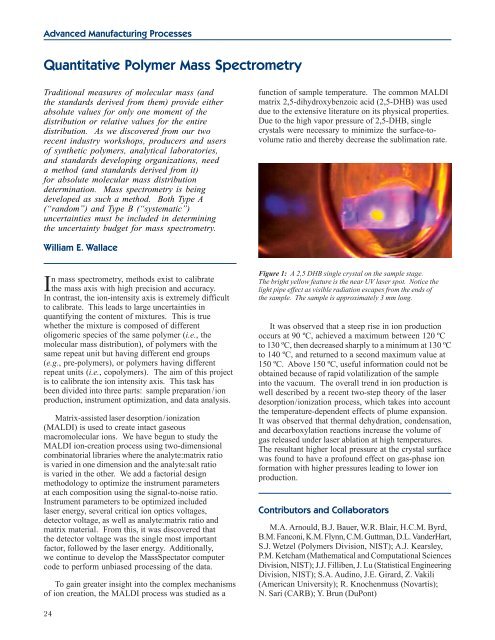Materials Science and Engineering Laboratory FY 2004 ... - NIST
Materials Science and Engineering Laboratory FY 2004 ... - NIST
Materials Science and Engineering Laboratory FY 2004 ... - NIST
Create successful ePaper yourself
Turn your PDF publications into a flip-book with our unique Google optimized e-Paper software.
Advanced Manufacturing Processes<br />
Quantitative Polymer Mass Spectrometry<br />
Traditional measures of molecular mass (<strong>and</strong><br />
the st<strong>and</strong>ards derived from them) provide either<br />
absolute values for only one moment of the<br />
distribution or relative values for the entire<br />
distribution. As we discovered from our two<br />
recent industry workshops, producers <strong>and</strong> users<br />
of synthetic polymers, analytical laboratories,<br />
<strong>and</strong> st<strong>and</strong>ards developing organizations, need<br />
a method (<strong>and</strong> st<strong>and</strong>ards derived from it)<br />
for absolute molecular mass distribution<br />
determination. Mass spectrometry is being<br />
developed as such a method. Both Type A<br />
(“r<strong>and</strong>om”) <strong>and</strong> Type B (“systematic”)<br />
uncertainties must be included in determining<br />
the uncertainty budget for mass spectrometry.<br />
William E. Wallace<br />
In mass spectrometry, methods exist to calibrate<br />
the mass axis with high precision <strong>and</strong> accuracy.<br />
In contrast, the ion-intensity axis is extremely difficult<br />
to calibrate. This leads to large uncertainties in<br />
quantifying the content of mixtures. This is true<br />
whether the mixture is composed of different<br />
oligomeric species of the same polymer (i.e., the<br />
molecular mass distribution), of polymers with the<br />
same repeat unit but having different end groups<br />
(e.g., pre-polymers), or polymers having different<br />
repeat units (i.e., copolymers). The aim of this project<br />
is to calibrate the ion intensity axis. This task has<br />
been divided into three parts: sample preparation /ion<br />
production, instrument optimization, <strong>and</strong> data analysis.<br />
Matrix-assisted laser desorption/ionization<br />
(MALDI) is used to create intact gaseous<br />
macromolecular ions. We have begun to study the<br />
MALDI ion-creation process using two-dimensional<br />
combinatorial libraries where the analyte:matrix ratio<br />
is varied in one dimension <strong>and</strong> the analyte:salt ratio<br />
is varied in the other. We add a factorial design<br />
methodology to optimize the instrument parameters<br />
at each composition using the signal-to-noise ratio.<br />
Instrument parameters to be optimized included<br />
laser energy, several critical ion optics voltages,<br />
detector voltage, as well as analyte:matrix ratio <strong>and</strong><br />
matrix material. From this, it was discovered that<br />
the detector voltage was the single most important<br />
factor, followed by the laser energy. Additionally,<br />
we continue to develop the MassSpectator computer<br />
code to perform unbiased processing of the data.<br />
To gain greater insight into the complex mechanisms<br />
of ion creation, the MALDI process was studied as a<br />
24<br />
function of sample temperature. The common MALDI<br />
matrix 2,5-dihydroxybenzoic acid (2,5-DHB) was used<br />
due to the extensive literature on its physical properties.<br />
Due to the high vapor pressure of 2,5-DHB, single<br />
crystals were necessary to minimize the surface-tovolume<br />
ratio <strong>and</strong> thereby decrease the sublimation rate.<br />
Figure 1: A 2,5 DHB single crystal on the sample stage.<br />
The bright yellow feature is the near UV laser spot. Notice the<br />
light pipe effect as visible radiation escapes from the ends of<br />
the sample. The sample is approximately 3 mm long.<br />
It was observed that a steep rise in ion production<br />
occurs at 90 ºC, achieved a maximum between 120 ºC<br />
to 130 ºC, then decreased sharply to a minimum at 130 ºC<br />
to 140 ºC, <strong>and</strong> returned to a second maximum value at<br />
150 ºC. Above 150 ºC, useful information could not be<br />
obtained because of rapid volatilization of the sample<br />
into the vacuum. The overall trend in ion production is<br />
well described by a recent two-step theory of the laser<br />
desorption/ionization process, which takes into account<br />
the temperature-dependent effects of plume expansion.<br />
It was observed that thermal dehydration, condensation,<br />
<strong>and</strong> decarboxylation reactions increase the volume of<br />
gas released under laser ablation at high temperatures.<br />
The resultant higher local pressure at the crystal surface<br />
was found to have a profound effect on gas-phase ion<br />
formation with higher pressures leading to lower ion<br />
production.<br />
Contributors <strong>and</strong> Collaborators<br />
M.A. Arnould, B.J. Bauer, W.R. Blair, H.C.M. Byrd,<br />
B.M. Fanconi, K.M. Flynn, C.M. Guttman, D.L. V<strong>and</strong>erHart,<br />
S.J. Wetzel (Polymers Division, <strong>NIST</strong>); A.J. Kearsley,<br />
P.M. Ketcham (Mathematical <strong>and</strong> Computational <strong>Science</strong>s<br />
Division, <strong>NIST</strong>); J.J. Filliben, J. Lu (Statistical <strong>Engineering</strong><br />
Division, <strong>NIST</strong>); S.A. Audino, J.E. Girard, Z. Vakili<br />
(American University); R. Knochenmuss (Novartis);<br />
N. Sari (CARB); Y. Brun (DuPont)

















